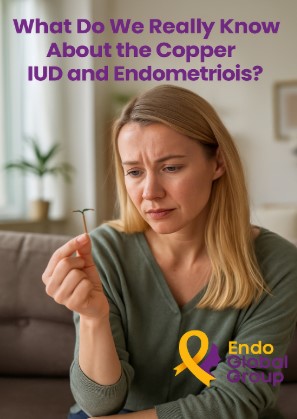Endoglobal Group – Educational Blog At Endoglobal Group, we are committed to sharing up-to-date, evidence-based information on reproductive health and endometriosis. Today we tackle a common question: could the copper intrauterine device (IUD) influence the development or progression of endometriosis? A Popular Method, But Not Entirely Neutral The copper IUD is one of the world’s …
Endoglobal Group – Educational Blog
At Endoglobal Group, we are committed to sharing up-to-date, evidence-based information on reproductive health and endometriosis. Today we tackle a common question: could the copper intrauterine device (IUD) influence the development or progression of endometriosis?
A Popular Method, But Not Entirely Neutral
The copper IUD is one of the world’s most widely used contraceptives because it contains no hormones. Yet “non-hormonal” does not necessarily mean “biologically inert.” Several studies show that copper IUDs increase menstrual bleeding by roughly 50–100 % compared with pre-insertion levels. This matters because heavy bleeding is a recognized risk factor for endometriosis.
Nulliparity (never having given birth) is also linked to higher endometriosis risk. The typical copper IUD user profile —young, nulliparous women— overlaps with these factors.
Copper: Essential Trace Element and Metalloestrogen
Copper is indispensable in tiny amounts but can be toxic when levels are excessive. It is officially classified as a “metalloestrogen”: a metal capable of binding to hormone receptors and mimicking or disrupting estrogen and progesterone signaling. This raises the possibility of endocrine disruption —a key mechanism in estrogen-dependent conditions such as endometriosis and some gynecologic cancers.
Mechanistic research also describes phenomena such as cuproptosis (copper-induced cell death) and stimulation of angiogenesis (formation of new blood vessels), processes that could, in theory, promote endometriosis lesion growth.
What Studies Show So Far
Copper IUD users bleed more, and some have higher blood copper levels than non-users.
Laboratory studies show copper can harm ovarian cells and alter key steroidogenesis enzymes.
Case reports exist of endometriomas appearing after IUD insertion, although these do not prove causality.
In short, there is biological plausibility and warning signals, but no large prospective studies yet proving that copper IUDs cause endometriosis.
Why a Gender Lens Matters
Historically, women’s health risks have been underestimated. In some countries, copper IUDs were inserted without informed consent as part of population-control programs. Understanding their real effects is not only a scientific issue but also one of transparency, reproductive autonomy, and equity in medical research.
What Patients Can Do
Alternatives exist, such as newer hormonal IUDs, which reduce menstrual bleeding and may be better suited for women at risk of endometriosis. Discuss the pros and cons of each method with your healthcare provider and request full information before deciding.
Our Position
At Endoglobal Group we believe women’s reproductive health deserves independent, up-to-date research. A prospective European study following nulliparous women with copper IUDs compared with controls is urgently needed to clarify this possible link.
Bottom line: The copper IUD remains an effective contraceptive but may not be as “harmless” as commonly perceived. Transparent information is the first step toward truly informed choice.





